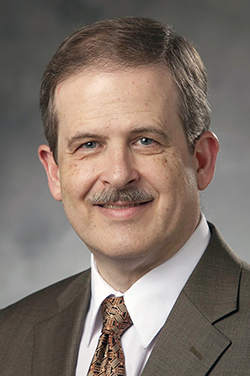
As the year comes to a close, I am pleased to report on the activities of Education Council during 2017. There are several items that deserve particular mention.
Over the past decade, much work has been done to increase the number of residency training programs. This has been a great success, as we have increased from about 25 residency slots per year in 2008 up to about 160-170 residency slots per year today. We have 94 accredited therapy programs, 19 accredited imaging programs, and four accredited DMP programs. Our initial estimate based on the workforce analysis done in 2010 was that about 145-175 total residency slots were needed per year, so we are virtually at where we need to be. Additional good news is that there appears to be only minimal loss of slots by attrition. We do need to continue to monitor the number of residency slots and that is one of the major ongoing initiatives of Education Council. We are working collaboratively with Professional Council, SDAMPP, and CAMPEP to collect data that will enable us to understand whether these available residency slots are appropriately matched to the current needs of work force.
One area of particular emphasis is ascertaining whether additional imaging residency slots are needed. There is a general sense that the field is undersupplied with qualified imaging physicists, so we are working with President Melissa Martin and others to explore options for increasing the number of physicists in diagnostic imaging. We are exploring options for how we might add to the number of available training slots in imaging.
The efforts of the Subcommittee on the Oversight of MedPhys Match, chaired by John Antolak, have borne great fruit over the past three years. We just completed the third round of the match and there were 224 total applicants with 107 matched. A roughly equal number of MS and PhD candidates from CAMPEP programs matched, though a smaller percentage for the Masters candidates, indicating that there is a residency pathway available for both types of students.
We have a very active Students and Trainees Subcommittee, chaired by Anna Rodrigues, that has provided a number of workshops and activities for our medical physicists in training. Among these efforts are activities to highlight different career pathways for individuals in medical physics. While many (or even most) of our trainees will explore a clinical career path, medical physicists can also provide valuable service in non-clinical areas such as academic research, industry, and government labs. We want to make sure that our trainees are well informed about the variety of career paths that are available today.
We also have several initiatives in place for the coming year. One is to produce useful material for the general public to inform them about issues of risk and benefit from uses of radiation in medicine, and to highlight the role of medical physicists as experts in such areas. Our Public Education Committee, chaired by George Sandison, is undertaking this effort. Another initiative is to explore further areas of online educational materials. And a third is an upcoming two-day workshop on educational methods in medical physics just prior to next year's Annual Meeting. The Medical Physicists as Educators Committee, chaired by Victor Montemayor, is putting on this workshop, and I encourage you to put it on your calendar for next summer and plan to attend.
We always welcome feedback from the AAPM membership on issues of importance in our education and training mission. We look forward to hearing from you.
We have noticed that you have an ad blocker enabled which restricts ads served on this site.
Please disable it to continue reading AAPM Newsletter